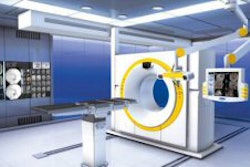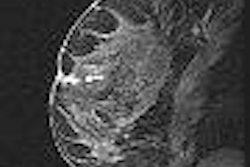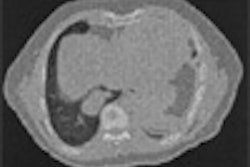BERLIN - At least 20% of a uterine fibroid treated with MRI-guided focused ultrasound (MRgFUS) therapy must be properly ablated to achieve long-lasting volume changes, according to Boston researchers who are experienced with the technique. The team presented its work this week at the International Society for Magnetic Resonance in Medicine (ISMRM) meeting.
Dr. Zsuzsana Lenard's group conducted a retrospective study of 66 women who underwent MRgFUS for uterine leiomyomas. The patients were followed up at six, 12, and 24 months. The mean patient age was 45 years and the mean tumor volume was 250 cc. The ExAblate 2000 system was used and the manufacturer, InSightec of Haifa, Israel, provided funding for the clinical exams.
"Focused ultrasound is a noninvasive, thermal ablative technique, using ultrasound or MR guidance, that provides an alternative to surgical resection," said Nathan McDannold, Ph.D., who presented the data on behalf of Lenard and their other colleagues at Brigham and Women's Hospital in Boston.
"During the treatment we use MR thermometry to make sure that we are correctly targeted and that we're using the correct power levels," McDannold said. "Then we can use the temperature profiles, as a function of time at each voxel, and predict online which regions have received a lethal single dose. After the treatment, we give MR contrast to look at nonenhancing volume."
MRI was done on a 1.5-tesla system (GE Healthcare, Chalfont St. Giles, U.K.) for sonication localization and temperature monitoring. Lenard then went through the images and segmented the fibroids, before and after treatment, at the various time points. She used open-source software for this analysis (3D Slicer, www.slicer.org). Fibroids were grouped into dark and bright, with bright fibroids having a signal greater than the signal in the uterus, McDannold said.
In addition, the percentage of the fibroid that did not enhance on MRI immediately after the procedure was compared with volumes at different time points.
According to the results, the mean total volume before MRgFUS was 255.5 mm3. After one year, total volume was reduced by 9.3% and patient-reported symptom severity scores were reduced by 37.4%.
But in the 24 cases followed up at two years, the fibroids had actually grown to a value larger than pretreatment, McDannold said, although the symptom scores remained the same. Possible reasons for this sustained relief may include vascular and hormonal changes, increased tolerance over time, or a placebo effect, he suggested.
In terms of bright and dark fibroid appearance on T2-weighted MRI, the authors found that those with a dark appearance were more effectively treated. On the other hand, brighter fibroids required higher power treatment. These fibroids were more difficult to heat, and patients could not tolerate the increased power, McDannold said. Co-author Dr. Clare Tempany added that the T2 signal corresponded with cellularity, rendering them more resistant to treatment.
The authors theorized that the following may serve as predictors of MRgFUS therapy success: Signal intensity on T2-weighted images with greater volume reduction in low-signal fibroids and a nonperfused area of 20% post-treatment may be required for reliable shrinkage. These findings could serve as a guideline for patient selection for MRgFUS, they added.
In a paper published last year, McDannold, Tempany, and others from the hospital reported good correlation for smaller treatment volumes at a lower dose threshold (Radiology, July 2006, Vol. 240:1, pp. 263-272).
By Shalmali Pal
AuntMinnie.com staff writer
May 23, 2007
Related Reading
FDA clears InSightec's ExAblate 2000 for GE 3T MRI, March 1, 2007
Hormone therapy boosts efficacy of ultrasound therapy for uterine leiomyomata, July 5, 2006
Rapid interleaved technique speeds MRgFUS fibroid treatment, May 2, 2006
Focused ultrasound effective against uterine fibroids, February 9, 2006
MRgFUS provides effective, noninvasive treatment for uterine fibroids, November30, 2005
Copyright © 2007 AuntMinnie.com



















